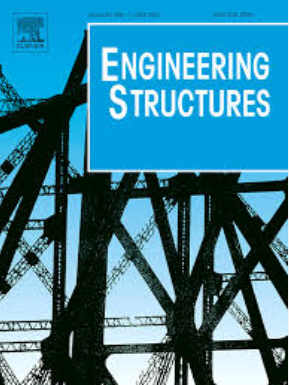Data-driven digital twin framework for large-scale dynamic structures based on model reduction and damage regression identification
IF 5.6
1区 工程技术
Q1 ENGINEERING, CIVIL
引用次数: 0
Abstract
A framework and construction method for data-driven digital twin of large-scale dynamic structures based on model order reduction (MOR) and damage regression identification are proposed. The Krylov subspace order reduction method is used to reduce the orders of the high-fidelity finite element (FE) models corresponding to the possible damaged states of the structure during service, and a reduced-order model library is then set up. Using the models in the library, the dynamic responses of the damaged structure are quickly computed. With the dynamic response dataset, the damage regression identification model of the structure is established by the MLP-ResNet algorithm and used to update the digital twin following the evolution of the damaged state of the structure. Combining the proper orthogonal decomposition (POD) and deep learning algorithm, a surrogate model for the Krylov subspace projection matrices of the reduced-order models corresponding to the identified damaged states which are not included in the reduced-order model library is established. Using the surrogate model, the projection matrices and the dynamic responses of the damaged structure can be quickly calculated. The efficiency of the digital twin driven by the sensor data is demonstrated by a physical frame structure experimentally and numerically, and the suitability of the method for a large-scale structure is illustrated with the digital twin of a transmission tower. However, the damaged states of a structure during service and the type of sensors and their assignment scheme should be designed specifically in applications.
求助全文
约1分钟内获得全文
求助全文
来源期刊

Engineering Structures
工程技术-工程:土木
CiteScore
10.20
自引率
14.50%
发文量
1385
审稿时长
67 days
期刊介绍:
Engineering Structures provides a forum for a broad blend of scientific and technical papers to reflect the evolving needs of the structural engineering and structural mechanics communities. Particularly welcome are contributions dealing with applications of structural engineering and mechanics principles in all areas of technology. The journal aspires to a broad and integrated coverage of the effects of dynamic loadings and of the modelling techniques whereby the structural response to these loadings may be computed.
The scope of Engineering Structures encompasses, but is not restricted to, the following areas: infrastructure engineering; earthquake engineering; structure-fluid-soil interaction; wind engineering; fire engineering; blast engineering; structural reliability/stability; life assessment/integrity; structural health monitoring; multi-hazard engineering; structural dynamics; optimization; expert systems; experimental modelling; performance-based design; multiscale analysis; value engineering.
Topics of interest include: tall buildings; innovative structures; environmentally responsive structures; bridges; stadiums; commercial and public buildings; transmission towers; television and telecommunication masts; foldable structures; cooling towers; plates and shells; suspension structures; protective structures; smart structures; nuclear reactors; dams; pressure vessels; pipelines; tunnels.
Engineering Structures also publishes review articles, short communications and discussions, book reviews, and a diary on international events related to any aspect of structural engineering.
 求助内容:
求助内容: 应助结果提醒方式:
应助结果提醒方式:


